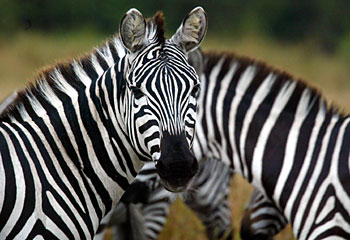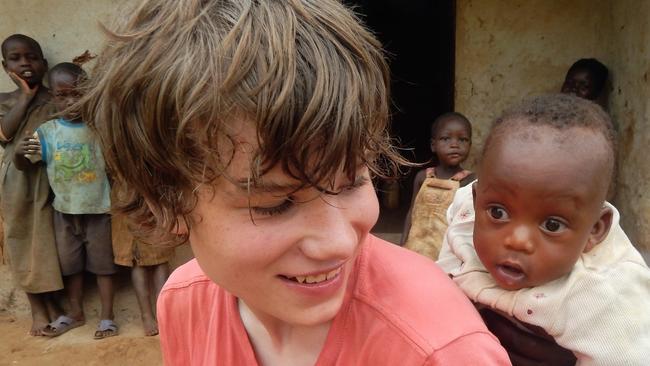Game on in nature's heartland
WHAT price is a thirsty zebra willing to pay for a drink? asks Tim Swinstead from South Africa's Madikwe Game Reserve.

WHAT price is a thirsty zebra willing to pay for a drink? It is dusk at a waterhole in South Africa's Madikwe Game Reserve and the zebra has spent all day in the baking sun. But he needs to be careful.
We safari-goers are watching. The zebra doesn't know it, but other eyes are on him, too. Hungry eyes.
Our guide, Natie, a former big-game hunter, has told us a couple of lionesses have staked out the area and if we're quiet and lucky we might see something out of the ordinary.
Suddenly the tranquil scene erupts in clouds of dust and action: the lionesses spring from behind bushes uphill to our left. The zebra is off and the chase is on.
Prey and predators disappear from view around a corner and into bushes. Sounds form the only clue to the outcome of the chase; the grunting, tearing and squealing confirms the kill has been made.
Such is the nature of nature in Africa. Thirsty one minute – satisfying someone else's hunger the next.
Nothing you will see on Animal Planet or National Geographic Channel prepares you for the sights, sounds, colours and smells of Africa close up.
The chase and kill at the waterhole is a highlight of a memorable stay at Jaci's Safari Lodge, a five-star resort amid this untamed 75,000ha reserve on the edge of the Kalahari, adjoining the South Africa-Botswana border.
Inside the lodge we are safe; protected by an electric fence.
Outside, wild Africa is on show and life goes on pretty much as it did eons ago when, according to the anthropologists, our ancestors descended from the trees here.
It's a tribute to our ingenuity that we were able to hold off such competition in this land of the quick or the dead and evolve into the planet's dominant species.
To put Africa's amazing biodiversity in context, consider its contrast to arid, sparsely inhabited Australia. When Europeans arrived on mainland Australia, the continent's major land predators consisted of the Aborigines, non-indigenous dingoes (from South-East Asia) and the perentie (monitor). The fossil record shows marsupial wolves, lions and mega-fauna once inhabited a greener, lusher land.
Africa still has fearsome predators like these – among them lions, leopards, cheetahs, hyenas, African wild dogs, jackals, bat-eared foxes and any number of smaller carnivores.
Africa still has mega-fauna such as elephants, hippos, giraffes and rhinos. Nothing prepares you for their massive size, particularly the bizarre, prehistoric rhino, of which only about 10,000 remain in the world.
The herbivores are similarly diverse. Impala are a dime a dozen and there are buffalo, bush pig, warthog, kudu, eland and every type of 'beest, 'buck and 'bok you can think of: hartebeest and wildebeest; bushbuck, reedbuck and waterbuck; gemsbok, springbok and steenbok.
And one fewer zebra.
Then there are the primates; baboons, vervets and various other monkeys.
Without mentioning birds, reptiles or amphibians, it's suffice to say the place is teeming with wildlife, all creatures great and small.
In just three days at Madikwe, only three hours' drive from South Africa's biggest city, Johannesburg, we see many of these creatures and more. Every morning or evening drive in the safari vehicle is a fascinating adventure school.
Immediately after the zebra kill, Natie takes us to the far side of the watering hole where we are lucky enough to see a small herd of elephants taking a mud bath. He explains that it is their favourite part of the day as they wallow and play together and important to their survival, as the mud acts as a sunscreen and offers protection against insect bites and moisture loss.
The next day our enthusiastic guide announces he has something to show us and drives us to a clearing where we see a lioness and her two cubs. We are close, perhaps only 10 or 15 metres.
One of us, clad in safari shorts and a white T-shirt, nervously asks: "What is the worst colour to wear on safari?"
"White," Natie tells her, without looking around. "The animals don't like it."
But the lions don't seem to mind. They are used to these vehicles and do not regard us as a threat.
Mum has obviously had her fill and is resting. The cubs are playing with the remains of something that has been dragged under the shelter of a tree. We strain to see what it used to be . . . sure enough, part of the hind quarters of a zebra, maybe our unlucky, thirsty friend of the night before.
On the way home that night after drinks we chance upon a lone elephant feeding beside the track. She is enormous and very close. She too seems oblivious of our presence and simply carries on eating, but for once Natie seems wary. He explains that she may have a baby nearby; elephants are protective of their young and have been known to charge.
At nearby Madikwe Safari Lodge, we stay in luxury accommodation similar to Jaci's, but without the electric fence we are escorted to our rooms at night.
Elephants have been known to drink from the plunge pools located at the back of each unit and during the cooler months lions have been seen basking under the lights that flank the path to the rooms. And baboons tend to lose their fear of humans and, being opportunistic feeders, can cause mischief.
At Madikwe we are treated to hospitality, African style. The entire staff appears from nowhere, serenading us loudly in beautiful African harmonies. Unfortunately, they want us to dance with them ... particularly unfortunate for me, living proof that white men can't dance.
On our last safari the next morning, our new guide, Mark, has us in stitches, explaining the stupidity of the ubiquitous wildebeest.
"Dopey animals," he says. "They run around in circles. They run into trees. The stupidest animals here, bar none."
I ask: "Well if they are so stupid, how can they survive out here?"
"To survive, they have only to be smarter than the dumbest one in the herd," he says.
We stop in a clearing for morning coffee and rusks.
Mark, 21, just out of ranger school and a bit of a lad, tries to engage us in a bushbuck dung-spitting contest.
There's an art to it, he says, as he pops a pebble-sized pellet into his mouth, muttering something about getting it nice and slippery and making sure it comes out pointy end first.
He draws a line in the sand, takes a Brett Lee-length run up and, with a snap of the head, lets fly, sending the projectile an impressive distance. There are no other takers. He can remain bushbuck dung-spitting champion of all South Africa.
On the trip back to the lodge, Mark spies elephant dung on the road ahead. He stops, gets out and picks up a piece the size of a loaf of bread.
Surely he is not going to try to spit this, too.
No, he uses it to explain how Africa's bushmen used the dung to transfer fire from place to place: cut it in two, put some embers in, then tie the two pieces back together; it smoulders all day for a new fire to be made the next night.
This drive is particularly fruitful. In the space of a couple of hours we see warthogs, baboons, giraffes, zebras and lions. A herd of about 30 elephants, including young ones, crosses the road in front of us.
An hour later we are heading for Cape Town.
I conclude that wild Africa is a trip that anyone with the means should do at least once in their lifetime. I'll be going back.
Sunday Herald Sun



